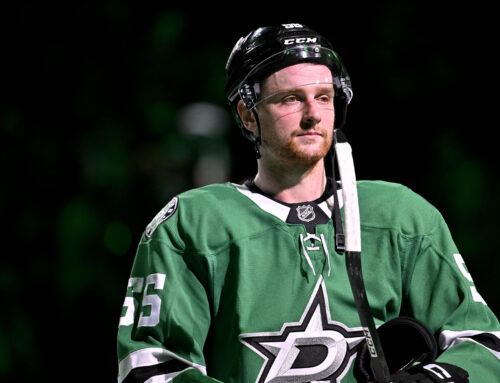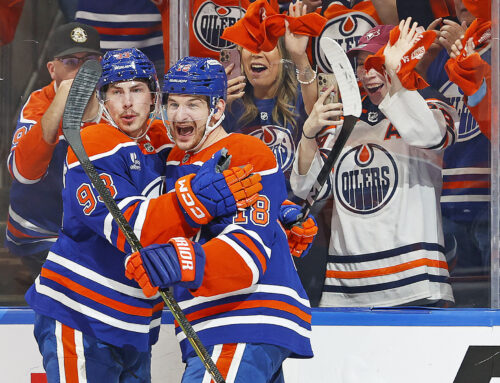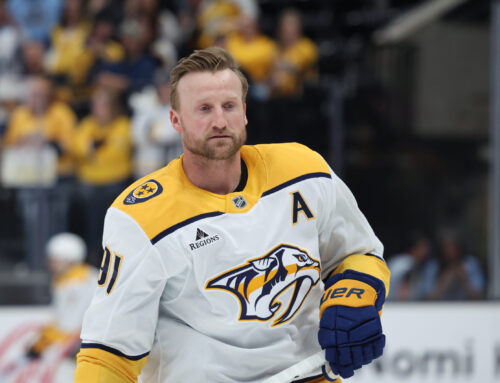
Anaheim’s Crease Getting Crowded…
Every National Hockey League organization is looking for that goalie that can steal a game or carry the team on his back from time-to-time. It’s difficult to have any sort of long-term postseason success without some steady play between the pipes. Although the Anaheim Ducks made an early exit from this year’s Stanley Cup playoffs, they currently have the good fortune of having two netminders that they can rely on in Jonas Hiller and Viktor Fasth.
The combination of Hiller and Fasth helped propel the Ducks to a surprising second place finish in the Western Conference. In many ways the performance of both goalies was a pleasant surprise. Hiller has established himself as top goaltender in recent years, but he had a slightly down year in 2011-12 after battling a bout of vertigo the year prior. Fasth on the other hand was a relative unknown and made a name for himself in 2013 as a 30-year-old first-year netminder from Sweden.
The great thing about comparing the play this year of Hiller and Fasth is that they both have such similar stat lines to work with. They started 25 and 23 games respectively, and they both had 15 wins and six losses. Not only that, but when you look at the shots they faced there is less and less separation between the two. Hiller faced 675 shots this season compared to Fasth’s 661. That’s as close as you are going to find for two goalies on the same squad.
If we delve a little deeper into the shots on goal, the similarities in the goaltender's play are remarkable. Hiller and Fasth both averaged about 26 shots faced per game, and the average distance they were coming from was 33.48 and 33.64 feet respectively. That difference is negligible and doesn’t really give any insight into who might have performed better this season.
When you break down their numbers on shots from 1-15 feet, once again their stats are eerily close. On shots from that distance, which are typically the toughest to stop, Fasth had a .868 save percentage and Hiller posted a .864 mark. Both of those totals were among the top six in goalies that played in 20 or more games in 2013.
If there was an area where you could start to see a difference though, it would be on shots from 30-45 feet. Fasth had a stellar .954 save percentage on shots from that distance and ranked just outside the top 10 in the league. Hiller, however, only recorded a .918 and put him 27th among goalies. Those are stops goaltenders have to make at the NHL level, so these numbers could indicate Hiller was giving up the odd bad goal.
So how should Anaheim approach the off-season with their two seemingly capable starting goalies? And better yet, what can poolies expect going forward from each? Well logically it may make sense for the Ducks to part with Hiller and keep Fasth. Hiller is a UFA after next season so trading him would be convenient, since Fasth is already signed for the next two seasons at a more cap friendly deal of $2.9M. Hiller is making $4.5M and it’s going to cost the Ducks at least that much per season to re-sign him, if not more. Spending that kind of money on two goalies isn’t feasible for most teams.
With that being said, how much do the Ducks really trust Fasth? Although his overall numbers were better than Hiller’s this year with an impressive .921 save percentage and a 2.18 goals against average, he is working off of a very small sample size. Any team banking on a goalie to carry them for the foreseeable future that has only appeared in 25 career games is not doing its due diligence.
To further that point, if you look at Fasth’s wins this season there is some evidence that indicates he feasted on bad competition. Of his 15 victories, nine of them came against non-playoff games. If the Ducks were to declare him the starter for 2013-14 with a full 82-game campaign, the challenges and pressures would be a lot different, especially if Fasth didn’t have another reliable goalie like Hiller to fall back on.
There is another wild-card option Anaheim could employ in the future, and that would be John Gibson. The young American netminder has been a standout for the Kitchener Rangers of the Ontario Hockey League and most notably this year at the World Junior Hockey Championship. Gibson led the United States squad to a gold medal by posting a .954 SP and a 1.36 GAA. He might not be ready for the NHL just yet, but he had a strong showing recently against world class talent when he helped the US to the bronze at the World Hockey Championship. Anaheim may be more confident in going with Fasth if they feel Gibson is ready to be a contingency plan.
Now having two strong goalies on the same team is all well and good for the Ducks, however, poolies may not share Anaheim’s excitement. As a fantasy owner you would surely love to have either one on your squad, but splitting time in the crease isn’t going to help the overall production for your team. Unless of course you managed to acquire both of them on your roster.
How the Ducks handle this off-season in regards to their goalies will affect the fantasy landscape for next year greatly, and poolies will be anxiously waiting on their decision.
Feel free to follow me on Twitter at @amato_mike
Other Wild West Columns
| Colorado Is On The Clock | |||
| Can Pekka Rinne Bounce Back? | |||
| The Future is Bright on the Kings Blue Line | |||
| Ryan Suter Thriving On His Own |
|





 SEA
SEA NYI
NYI BUF
BUF DAL
DAL
 CBJ
CBJ NYR
NYR ANA
ANA STL
STL L.A
L.A
